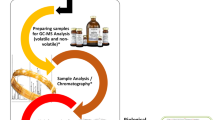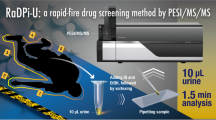Abstract
Dermorphin is a unique opioid peptide that is 30–40 times more potent than morphine. It was misused and went undetected in horse racing until 2011 when intelligence obtained from a few North American race tracks suggested its use. To prevent such misuse, a reliable analytical method became necessary for detection and identification of dermorphin in post-race horse samples. This paper describes the first liquid chromatography–tandem mass spectrometry (LC–MS/MS) method for such a purpose. Equine plasma and urine samples were pre-treated with ethylenediamine tetra-acetic acid and urea prior to solid-phase extraction (SPE) on Oasis MCX cartridges. Resulting eluates were dried under vacuum and analyzed by LC–MS/MS for dermorphin. The matrix effect, SPE efficiency, intra-day and inter-day accuracy and precision, and stability of the analyte were assessed. The limit of detection was 10 pg/mL in plasma and 20 pg/mL in urine, and the limit of confirmation was 20 pg/mL in plasma and 50 pg/mL in urine. Dermorphin in plasma is stable at ambient temperature, but its diastereomer is unstable. With isotopically labeled dermorphin as an internal standard, the quantification range was 20–10,000 pg/mL in plasma and 50–20,000 pg/mL in urine. The intra-day and inter-day accuracy was from 91 % to 100 % for the low, intermediate, and high concentrations. The intra-day and inter-day coefficients of variation were less than 12 %. The method differentiates dermorphin from its diastereomer. This method is very specific for identification of dermorphin in equine plasma and urine, as assessed by BLAST search and targeted SEQUEST search, and by MS/MS spectrum library search. The method has been successfully applied to analysis of samples collected following dermorphin administration to research horses and of official post-race samples.

ᅟ




Similar content being viewed by others
References
Montecucchi PC, Henschen A (1981) Amino acid composition and sequence analysis of sauvagine, a new active peptide from the skin of Phyllomedusa sauvagei. Int J Pept Protein Res 18(2):113–120
Montecucchi PC, de Castiglione R, Piani S, Gozzini L, Erspamer V (1981) Amino acid composition and sequence of dermorphin, a novel opiate-like peptide from the skin of Phyllomedusa sauvagei. Int J Pept Protein Res 17(3):275–283
Montecucchi PC, de Castiglione R, Erspamer V (1981) Identification of dermorphin and Hyp6-dermorphin in skin extracts of the Brazilian frog Phyllomedusa rhodei. Int J Pept Protein Res 17(3):316–321
Broccardo M, Erspamer V, Falconieri Erspamer G, Improta G, Linari G, Melchiorri P, Montecucchi PC (1981) Pharmacological data on dermorphins, a new class of potent opioid peptides from amphibian skin. Br J Pharmacol 73(3):625–631
Melchiorri P, Negri L (1996) The dermorphin peptide family. Gen Pharmacol 27(7):1099–1107
Negri L, Melchiorri P, Lattanzi R (2000) Pharmacology of amphibian opiate peptides. Peptides 21(11):1639–1647
Scalia S, Salvadori S, Marastoni M, Bortolotti F, Tomatis R (1986) Reversed-phase HPLC study on the in vitro enzymic degradation of dermorphin. Peptides 7(2):247–251
Solaas KM, Skjeldal O, Gardner MLG, Kase FB, Reichelt KL (2002) Urinary peptides in Rett syndrome. Autism 6(3):315–328
Fouda H, Nocerini M, Schneider R, Gedutis C (1991) Quantitative analysis by high-performance liquid chromatography atmospheric-pressure chemical ionization mass spectrometry: the determination of the renin inhibitor CP-80,794 in human serum. J Am Soc Mass Spectrom 2(2):164–167. doi:10.1016/1044-0305(91)80010-5
Muddiman DC, Gusev AI, Proctor A, Hercules DM, Venkataramanan R, Diven W (1994) Quantitative measurement of cyclosporin A in blood by time-of-flight mass spectrometry. Anal Chem 66(14):2362–2368
Lawless MK, Hopkins S, Anwer MK (1998) Quantitation of a 36-amino-acid peptide inhibitor of HIV-1 membrane fusion in animal and human plasma using high-performance liquid chromatography and fluorescence detection. J Chromatogr B: Biomed Sci Appl 707(1–2):213–217
Yamaguchi K, Takashima M, Uchimura T, Kobayashi S (2000) Development of a sensitive liquid chromatography–electrospray ionization mass spectrometry method for the measurement of KW-5139 in rat plasma. Biomed Chromatogr 14(2):77–81
Márquez CD, Weintraub ST, Smith PC (1997) Quantitative analysis of two opioid peptides in plasma by liquid chromatography–electrospray ionization tandem mass spectrometry. J Chromatogr B Biomed Sci Appl 694(1):21–30
Niwa M, Enomoto K, Yamashita K (1999) Measurement of the novel decapeptide cetrorelix in human plasma and urine by liquid chromatography–electrospray ionization mass spectrometry. J Chromatogr B Biomed Sci Appl 729(1–2):245–253
Darby SM, Miller ML, Allen RO, LeBeau M (2001) A mass spectrometric method for quantitation of intact insulin in blood samples. J Anal Toxicol 25(1):8–14
van den Broek I, Sparidans RW, Huitema ADR, Schellens JHM, Beijnen JH (2006) Development and validation of a quantitative assay for the measurement of two HIV-fusion inhibitors, enfuvirtide and tifuvirtide, and one metabolite of enfuvirtide (M-20) in human plasma by liquid chromatography–tandem mass spectrometry. J Chromatogr B Analyt Technol Biomed Life Sci 837(1–2):49–58. doi:10.1016/j.jchromb.2006.03.059
Kannan V, Gadamsetty D, Rose M, Maria S, Mustafa I, Khedkar A, Dave N, Arumugam M, Iyer H (2010) Quantitative determination of oxytocin receptor antagonist atosiban in rat plasma by liquid chromatography–tandem mass spectrometry. J Chromatogr B Analyt Technol Biomed Life Sci 878(15–16):1069–1076. doi:10.1016/j.jchromb.2010.03.011
Dai S, Song H, Dou G, Qian X, Zhang Y, Cai Y, Liu X, Tang Z (2005) Quantification of sifuvirtide in monkey plasma by an on-line solid-phase extraction procedure combined with liquid chromatography/electrospray ionization tandem mass spectrometry. Rapid Commun Mass Spectrom 19(10):1273–1282. doi:10.1002/rcm.1917
Wolf R, Rosche F, Hoffmann T, Demuth HU (2001) Immunoprecipitation and liquid chromatographic–mass spectrometric determination of the peptide glucose-dependent insulinotropic polypeptides GIP1-42 and GIP3-42 from human plasma samples: new sensitive method to analyze physiological concentrations of peptide hormones. J Chromatogr A 926(1):21–27
Wolf R, Hoffmann T, Rosche F, Demuth HU (2004) Simultaneous determination of incretin hormones and their truncated forms from human plasma by immunoprecipitation and liquid chromatography–mass spectrometry. J Chromatogr B Analyt Technol Biomed Life Sci 803(1):91–99
John H, Walden M, Schäfer S, Genz S, Forssmann WG (2004) Analytical procedures for quantification of peptides in pharmaceutical research by liquid chromatography–mass spectrometry. Anal Bioanal Chem 378(4):883–897
Chambers E, Wagrowski-Diehl DM, Lu Z, Mazzeo JR (2007) Systematic and comprehensive strategy for reducing matrix effects in LC/MS/MS analyses. J Chromatogr B Analyt Technol Biomed Life Sci 852(1–2):22–34
Rose MJ, Fernandez-Metzler C, Johns BA, Sitko GR, Cook JJ, Yergey J (2005) Determination of potato carboxypeptidase inhibitor in African Green Monkey plasma using 96-well SPE and LC–MS/MS. J Pharm Biomed Anal 38(4):695–702. doi:10.1016/j.jpba.2004.09.059
Loevgren U, Johansson S, Jensen LS, Ekstroem C, Carlshaf A (2010) Quantitative determination of peptide drug in human plasma samples at low pg/ml levels using coupled column liquid chromatography–tandem mass spectrometry. J Pharm Biomed Anal 53(3):537–545. doi:10.1016/j.jpba.2010.03.024
Dongré AR, Jones JL, Somogyi Á, Wysocki VH (1996) Influence of peptide composition, gas-phase basicity, and chemical modification on fragmentation efficiency: evidence for the mobile proton model. J Am Chem Soc 118(35):8365–8374
Palzs B, Suhal S (2005) Fragmentation pathways of protonated peptides. Mass Spectrom Rev 24(4):508–548
Kroeff EP, Pietrzyk DJ (1978) High performance liquid chromatographic study of the retention and separation of short chain peptide diastereomers on a C8 bonded phase. Anal Chem 50(9):1353–1358. doi:10.1021/ac50031a040
Soukup-Hein RJ, Schneiderheinze J, Mehelic P, Armstrong DW (2007) LC and LC–MS separation of peptides on macrocyclic glycopeptide stationary phases: diastereomeric series and large peptides. Chromatographia 66(7–8):461–468
Adams CM, Zubarev RA (2005) Distinguishing and quantifying peptides and proteins containing D-amino acids by tandem mass spectrometry. Anal Chem 77(14):4571–4580
Matuszewski BK, Constanzer ML, Chavez-Eng CM (2003) Strategies for the assessment of matrix effect in quantitative bioanalytical methods based on HPLC–MS/MS. Anal Chem 75(13):3019–3030
Scalia S, Salvadori S, Marastoni M (1986) Reversed-phase HPLC study on the in vitro enzymic degradation of dermorphin. Peptides 7(2):247–251
Werle M, Bernkop-Schnürch A (2006) Strategies to improve plasma half life time of peptide and protein drugs. Amino Acids 30(4):351–367
Lambeir AM, Durinx C, Scharpé S, De Meester I (2003) Dipeptidyl-peptidase IV from bench to bedside: an update on structural properties, functions, and clinical aspects of the enzyme DPP IV. Crit Rev Clin Lab Sci 40(3):209–294
Oe T, Ackermann BL, Inoue K, Berna MJ, Garner CO, Gelfanova V, Dean RA, Siemers ER, Holtzman DM, Farlow MR, Blair IA, Oe T, Ackermann BL, Inoue K, Berna MJ, Garner CO, Gelfanova V, Dean RA, Siemers ER, Holtzman DM, Farlow MR, Blair IA (2006) Quantitative analysis of amyloid beta peptides in cerebrospinal fluid of Alzheimer's disease patients by immunoaffinity purification and stable isotope dilution liquid chromatography/negative electrospray ionization tandem mass spectrometry. Rapid Commun Mass Spectrom 20(24):3723–3735
Guan F, Uboh CE, Soma LR, Birks E, Chen J, You Y, Rudy J, Li X (2008) Differentiation and identification of recombinant human erythropoietin and darbepoetin alfa in equine plasma by LC–MS/MS for doping control. Anal Chem 80(10):3811–3817
Gonzalez-Antuna A, Rodriguez-Gonzalez P, Centineo G, Garcia Alonso JI (2010) Evaluation of minimal 13C-labelling for stable isotope dilution in organic analysis. Analyst 135(5):953–964
Gonzalez-Antuna A, Rodriguez-Gonzalez P, Lavandera I, Centineo G, Gotor V, Garcia Alonso JI (2012) Development of a routine method for the simultaneous confirmation and determination of clenbuterol in urine by minimal labeling isotope pattern deconvolution and GC–EI-MS. Anal Bioanal Chem 402(5):1879–1888
Acknowledgments
Financial support was provided by The Pennsylvania Racing Commissions, and financial contributions were made by the Pennsylvania Harness Horsemen Association at Pocono Downs and Chester Downs, Meadows Standardbred Owners Association, Horsemen Benevolent and Protective Association at Penn National and Presque Isles Downs. The authors thank Hilary Goff, Deborah Tsang, and Jesse Vanderhoef for their excellent technical assistance.
The ProteinProspector software developed by Dr. Alma Burlingame and his group at the University of California, San Francisco, California was used in interpreting product ions of dermorphin. BLAST search was performed using NCBI BLAST server (National Center for Biotechnology Information, USA).
Author information
Authors and Affiliations
Corresponding author
Electronic supplementary material
Below is the link to the electronic supplementary material.
ESM 1
(PDF 602 kb)
Rights and permissions
About this article
Cite this article
Guan, F., Uboh, C.E., Soma, L.R. et al. Detection, quantification, and identification of dermorphin in equine plasma and urine by LC–MS/MS for doping control. Anal Bioanal Chem 405, 4707–4717 (2013). https://doi.org/10.1007/s00216-013-6907-0
Received:
Revised:
Accepted:
Published:
Issue Date:
DOI: https://doi.org/10.1007/s00216-013-6907-0




